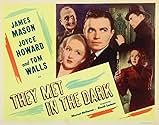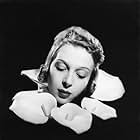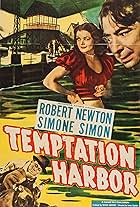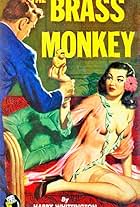During WW2, a Royal Navy Commander stumbles upon a murdered woman and discovers a network of Nazi spies and Fifth-Columnists.During WW2, a Royal Navy Commander stumbles upon a murdered woman and discovers a network of Nazi spies and Fifth-Columnists.During WW2, a Royal Navy Commander stumbles upon a murdered woman and discovers a network of Nazi spies and Fifth-Columnists.
Patricia Medina
- Mary - Manicurist
- (as Pat Medina)
Featured reviews
"They Met in the Dark" is like the first draft of a Hitchcock film, before the better plotting, interesting camera-work, and Hitchcock wit is added. In fact, it's a blend of "The 39 Steps" and "The Lady Vanishes." With many of the same elements:
Man and woman meet during a mysterious incident. Check. They are forced to stay on the run together. Check. The "McGuffin" is a secret message about the military. Check. The secret is conveyed by a music hall entertainer. Check. The unlikely couple end up in love. Check.
It's interesting to see the difference between a perfectly fine movie and a great one. Hitchcock created striking lighting effects, innovative camera moves, and darker, more menacing threat.
"They Met in the Dark" is a perfectly charming diversion and a nice, little movie. But pales in comparison to the Hitchcock films of the same era.
Man and woman meet during a mysterious incident. Check. They are forced to stay on the run together. Check. The "McGuffin" is a secret message about the military. Check. The secret is conveyed by a music hall entertainer. Check. The unlikely couple end up in love. Check.
It's interesting to see the difference between a perfectly fine movie and a great one. Hitchcock created striking lighting effects, innovative camera moves, and darker, more menacing threat.
"They Met in the Dark" is a perfectly charming diversion and a nice, little movie. But pales in comparison to the Hitchcock films of the same era.
A rather fishy intrigue going at any lengths to cause as much confusion as possible, as it basically only consists of loose ends all over, but it all starts at sea in the second world war, then proceeds to a court martial where James Mason appears to be convicted and dismissed from service, whereupon he shaves his beard and tries to get hold of a girl 'Mary' who has some awful things to tell him, which she never gets a chance to, as the old lorn house she has made an appointment with him in is empty except for a dead girl with a mysterious paper note clutched in her hand, which body is discovered by another girl, leading them to some circle of spies disguised as an entertainment company with mind readers, harmonica players and another singing girl, while James Mason is more interested in one girl than another, or is it the other way around? Anyway, there is nothing wrong with the acting or the intrigue-making, James Mason is always worth enjoying, but that's about all in this film - the death mystery in the desert house provides the only excitement, which never is satisfied, as the body disappears and never is recovered... Is it a comedy, a satire, just an entertainment made for kicks, is it seriously meant at all, or was it just made to fill some gap? The film inspires as many questions as an almost total lack of answers, but it provides at least some momentary entertainment...
The career that James Mason had before being discovered by Hollywood was quite prolific. Thanks to TCM, audiences have had the opportunity to see some of his British films. This one, "They Met in the Dark," is a 1943 noir, and has both elements of drama and humor. The film begins with a trial, after which, found guilty of treason, Richard Heritage (Mason) is stripped of rank and thrown out of the Navy. He sets out, with one of his crew who believes in him, to prove his innocence. He backtracks, repeating his actions from the day he was arrested.
He finds one woman (Patricia Medina) dead, another woman (Joyce Howard) positive that he had something to do with it, and a talent agent (Tom Walls) who has some interesting acts on his roster as well as a sophisticated singer (Phyllis Stanley).
Mason is handsome, elegant, and vital in the lead role. He handles the lighter moments very well and has lots of charm. It's easy to see why he eventually went to Hollywood. Stanley does some nice singing, and Ronald Chesney plays a great harmonica.
Different and enjoyable, with a good plot and British atmosphere that will keep the viewer interested.
He finds one woman (Patricia Medina) dead, another woman (Joyce Howard) positive that he had something to do with it, and a talent agent (Tom Walls) who has some interesting acts on his roster as well as a sophisticated singer (Phyllis Stanley).
Mason is handsome, elegant, and vital in the lead role. He handles the lighter moments very well and has lots of charm. It's easy to see why he eventually went to Hollywood. Stanley does some nice singing, and Ronald Chesney plays a great harmonica.
Different and enjoyable, with a good plot and British atmosphere that will keep the viewer interested.
This film is worth watching for Karel Lamac's direction. Born in the former Czechoslovakia and unknown to me I would very much like to discover his silent films. In this rather pedestrian film of murder, a dismissed man from the navy due to very dubious reasons, Lamac keeps the pace and adds the occasional visual flourishes that are exciting. There is an old dark house, a fleeting masked figure and a dead woman's body found by another woman which is visually stunning. The lighting has elements of Expressionism that heightens the horror, and in general the film is fascinating to watch. James Mason plays the dismissed man, and of course there has to be a heroine played adequately by Joyce Howard. Patricia Medina disappears far too quickly, and in my opinion I longed to see more of her, and would I feel have been better in the lead female role. Style wins over content here, but as Karel Lamac's style is so good the film is worth watching. A distinct European touch to very British material.
To begin, "They Met in the Dark" is a mystery that is seamlessly turned into a WWII espionage film, all the while remaining a film about two attractive and courageous people gradually falling in love. Analysts of recent vintage who try to watch the film, I suggest, routinely fail to understand its strengths and make too much of its very few weaknesses. It also confuses them because it is a film directed by a Czech, made with British actors, and yet its style is superior U.S. 1940s narrative of unusual clarity, swiftness of pace and occasional brilliance. The story involves a young naval officer who is cashiered from the service under suspicion of incompetence (James Mason) and who manages to become involved with a young woman (Joyce Howard) who finds a body and has cause to suspect him of having been the murderer. Following parallel paths--she to clear herself of suspicion in the case and he trying to find the truth about how his career came to grief over his botched assignment at sea--he tries to protect her while she is busy eluding him. The clues lead them both to a Dance Academy cum talent agency, which is really a nest of spies, wherein a quintet of villains has been manipulating innocents and finding a way to extract secret information from British naval officers, such as that knowledge those loss wreaked havoc on Mason's life. The last portion of the film, maintaining the light-hearted tone carried out throughout the proceedings, becomes an anti-espionage caper led by Mason and a fellow officer, leading to a very satisfying conclusion. Carl Lamac (as Karel Lamac) directed with a fluid and amazingly adept camera style, handling varying sorts of indoor and outdoor, group and chase, two-shot and nightclub scenes with extreme skill. Marcel Hellman produced, with music by Ben Frankel, outstanding cinematography by Otto Heller, art direction by Norma G. Arnold and period dance arrangements by Philip Bruchel. The screenplay was adapted from the oft-imitated novel "The Vanished Corpse" by Anthony Gilbert. Others involved in the screenplay included Basil Bartlett, Anatole de Grunwald, Victor MacLure, Miles Malleson, and James Seymour. Phyllis Stanley is outstanding as a singer, David Farrar and Edward Rigby are Mason's closest confederates. The evil quintet are portrayed by Ronald Ward, powerful Tom Walls as the leader, capable Karel Stepanek, Eric Mason, and Ronald Chesney, aided by Walter Crisham and Betty Warren. Brefni O'Rourke plays a police Inspector, with Kynaston Reeves, Terence de Marney, Robert Sansom, Patricia Medina and Peggy Dexter in supporting roles. As the young woman caught up in intrigue, Joyce Howard is far better here than she had been in the much darker "The Night Has Eyes"; though she lacks some voltage, she is attractive, and more than adequate. As the hero, James Mason gets to essay a great variety of interesting scenes, all of which he performs with convincing and skillful art throughout. He wins the girl in this one, but only after playing a variety of dramatic, comedic and challenging scenes; and as usual; he is able to sustain his character throughout the proceedings and make everyone around him look better than they do in the film at any other time. Comparing this delightful film to many routine program films of the war years, I suggest any critic worth his salt would have to applaud the success of this often brilliant entertainment. This is the sort of film people with a positive sense of life used to be able to make; I find it to be one within which complex story elements are made clear and scene follows scene with both logic and a continual sense of discovery. This is a very underrated noir adventure with most successful comedy used to advance the plot at every turn. Recommended.
Storyline
Did you know
- TriviaSince this was filmed in England during World War II, the odd-looking things on most cars' headlights are blackout deflectors. These kept the light pointed down at the road ahead and much less visible to enemy planes from above.
- GoofsWhen she was speaking to the Police, Laura said that the paper tore into 2 pieces and that a part of it was left in Mary's hand.
- Quotes
Henry: Nervous, aren't you? Don't worry, if you're legs are alright, you're alright.
Laura Verity: What do my legs got to do with it?
Henry: [looks over his glasses at her] You'd be surprised.
- Crazy creditsThe title card has the title of the film flashing on and off, like a neon sign.
- Alternate versionsBritish DVD release Version is Cut cinema reissue edition runs 94 minutes
Details
- Runtime1 hour 35 minutes
- Color
- Aspect ratio
- 1.37 : 1
Contribute to this page
Suggest an edit or add missing content































